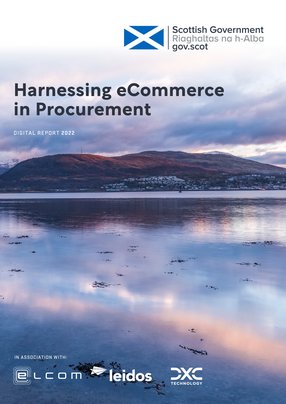As Deputy Director of eCommerce and Procurement Best Practice, Lynn Wisener, has been a part of the Scottish Government, and the Scottish Procurement and Property Directorate, since 1999.
“Like most graduates, I just applied for every job going,” says Wisener, “and 23 years ago, the Scottish Government was recruiting for procurement graduates and I was appointed as a Procurement Officer.”
She adds: “I have held quite a few different procurement positions during the last 23 years from operational procurement, to establishing one of the procurement Centres of Expertise, to the position that I hold now as Deputy Director of eCommerce and Procurement Best Practice.”
20 years of the eCommerce & Procurement Best Practice Shared Service
In the last 20 years, the Scottish Government, in collaboration with public sector bodies across Scotland, has been deploying its national eCommerce and Procurement Best Practice Shared Service to support, embed and underpin public procurement processes and procedures.
When she first joined the Scottish Procurement and Property Directorate there was pockets of collaboration across the public sector but, as Wisener explains, “there was recognition that there was duplication of effort and fragmentation of approach in how public bodies were engaging with the supplier base, how requirements were being tendered, and how contracts were being managed.”
“But we didn’t have a full picture,” says Wisener. “We didn’t have the data to support it, and it was a very laborious process to build an accurate picture of what was being bought, from whom and for how much, identify opportunities for future collaboration, and understand risk profiles across different commodities. So we created an eProcurement Strategy and put in place the national eCommerce & Procurement Best Practice Shared Service to digitally transform procurement, enable the gathering of vital supply chain data and intelligence and make it easier for suppliers to do business with the public sector.”
She adds: “In the last 20 years, we have gone from simply offering e-tendering (PCS-Tender) and purchase-to-pay (PECOS) capability, to providing a contract advertising portal (Public Contracts Scotland - PCS), spend analytics capability (the Procurement Information Hub), e-invoicing (PECOS), and enhanced catalogue management functionality (PECOS). We have also embedded Open Contracting and Open Government commitments via PCS where there is now a separate section that allows anyone to download contract opportunities and awards in a variety of different formats and we are continuing to enhance procurement transparency through the Scottish Government’s Open Government Action Plan. We are also improving our data and reporting capabilities through the delivery of a management information (MI) platform to provide enhanced business intelligence on procurement activity across Scotland.”
That’s not all, though: the Shared Service also provides procurement best-practice guidance for buyers and suppliers through the Procurement Journey and the Supplier Journey which provide step-by-step support and advice on how to procure through the public regime. Wisener and her team also work closely with the Supplier Development Programme which provides free training to Scottish SME suppliers and third sector organisations on how to win public contracts and grow their businesses.
And it’s not just the Scottish Government utilising these capabilities as Wisener explains “Our Shared Service is available to the entire public sector - health boards, local authorities, central government bodies, universities, colleges and third sector bodies. So we’ve got a huge amount of procurement activity operating across our entire service.”
It’s safe to say, this is no typical procurement solution.
“We have over 200 public bodies using our Shared Service,” says Wisener. “And we have thousands of suppliers interacting each day with these public bodies.”
Over the course of last year, the Service published over 11,000 contract opportunities, issued over 2,000 invitations to tender, processed over 2 million purchase orders with a combined value of approx. £7.6bn, validated over 323k eInvoices and analysed more than £13.3bn of public procurement spend.
“As you can see, the Shared Service manages a significant amount of procurement activity, supports a huge number of procurement professionals and suppliers, makes processes easier, streamlined and efficient, all of which maximises the impact of procurement to deliver a greener and fairer economy,” says Wisener.
She adds: “It also supports the 4 strategic objectives of public procurement in Scotland (#PowerofProcurement) which are, good for businesses and their employees, good for society, good for places and communities and open and connected”.
With it not only being the Scottish Government utilising the solutions provided, Wisener and her team are constantly looking at how the Shared Service can refresh, enhance and evolve through innovation such as robotics and artificial intelligence.
The government is also looking at how it can make reporting and management information more robust and accurate to support enhanced supply chain analysis as well as identify and evaluate associated risks and opportunities.
What’s next for the Scottish Government?
For the Scottish Government, the next stage of procurement transformation is going to be all about MI and data. “We’ve got such a lot of data which has a powerful story to tell,” says Wisener.
She adds: “But at the moment, it’s located in different solutions which makes it difficult to extract and bring together in a cohesive manner. So we are working on introducing an overarching Procurement MI Platform where we can bring data from key sources into one place and provide powerful business intelligence and enhanced reporting capabilities to enable public bodies to demonstrate the impact of their own procurement activity on their organisations as well as in the delivery of key outcomes at a local and national level.”
For the next 12 to 18 months, the Scottish Government will be working to refresh its eCommerce and Procurement Best Practice Strategy, consulting widely with its user base and the market in relation to what comes next in eCommerce and procurement solutions to ensure that the Service continues to deliver best-in-class capability, embeds innovation and enables public bodies and suppliers to maximise the #PowerofProcurement.






